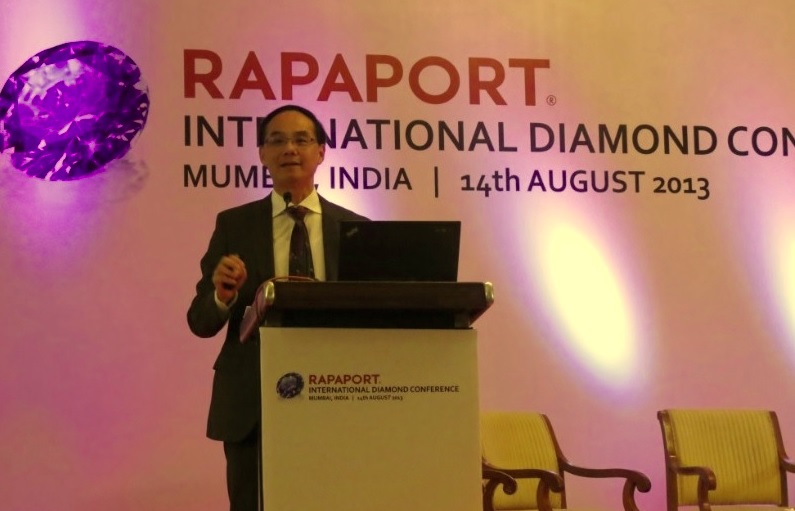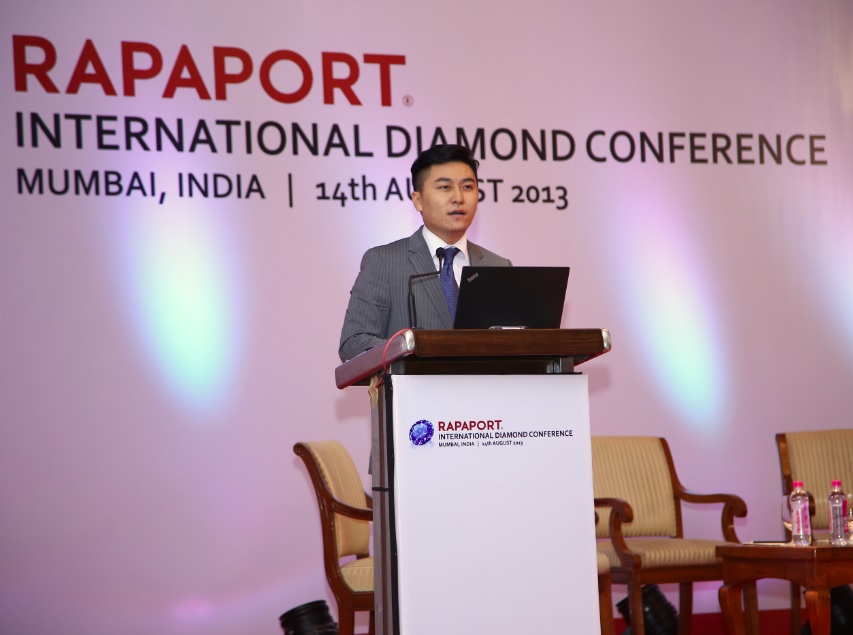|
|
Chow Tai Fook, China & the Diamond Industry
Editorial
Aug 16, 2013 5:17 AM
By Avi Krawitz
|
|
|
RAPAPORT... Diamond and jewelry companies in China are operating in a dynamic and changing environment. In 2013, as the country’s economic growth has slowed, albeit to an enviable 7.5 percent, polished diamond demand has become cautious, affecting sentiment in the global trade.
But that doesn’t necessarily affect China’s long-term diamond and jewelry growth story. The country’s wholesale and retail trade continues to work to better understand the demographic trends and evolving consumer preferences in the country to ensure their position in the market.
Kent Wong, managing director of Chow Tai Fook Jewellery (pictured), notes the cyclical nature of growth in the local jewelry market and attributed the recent caution to the government’s change in leadership.

“The leadership transition [which occurs once every 10 years] always brings a slowdown, and the new government has also implemented measures that have restrained demand, such as curbing gift-giving to government officials. That has affected sentiment in the luxury and jewelry segment,” Wong said at this week’s Rapaport International Diamond Conference (IDC). “So I would say that buying sentiment has mainly been affected by government measures and I believe we will see a recovery and confidence will improve in the second half of the year.”
Chow Tai Fook is considered the region’s largest jewelry retailer as its revenue increased 1.5 percent to $7.4 billion (HKD 57.4 billion) in fiscal year 2012-13; meanwhile, profit fell 17 percent to $730 million, due mainly to the economic slowdown. The company ended the year with 1,640 points of sale in Mainland China and 103 spread across Hong Kong, Macau and other Asian markets.
If the company expressed caution at the time, it changed its tone in the first quarter that ended June 30. Chow Tai Fook reported 63 percent revenue growth in the period driven by strong gold jewelry purchases when gold prices fell in mid-April. While Wong doesn’t expect the company will maintain such high growth levels for the remainder of the year, he recognized that consumers still see a buying opportunity in gold jewelry, as prices may have recovered but remain well below levels seen earlier in the year.
He added that the company’s diamond jewelry sales are forecasted to increase by single-digit percentages for the fiscal year, having increased by 8 percent in the first quarter, with growth driven by greater volume of sales.
The Young & the Affluent
In fact, Wong observed that the volume of China’s jewelry sales is constantly increasing, even if demand does fluctuate along with consumer sentiment when the market slows. Rather, he noted that consumers tend to shift to less expensive products in more cautious economic times.
As a result, jewelry sales in China have significantly outpaced general retail and economic growth in the past decade and the trend is expected to continue. Wong reported that the compound annual growth rate of China’s jewelry market has increased by 26 percent in the past five years and is expected to more than double to about $103 billion by 2015. By 2020, he expects China will match the U.S. as the largest jewelry market.
To capture that growth, Wong recognized the 20 to 30 year old age group as well as the affluent consumer segment as representing the greatest growth opportunity for the industry in China. Those segments are not included in the mass luxury jewelry segment – where price points fall between $256 and $12,820 – which contributes about 80 percent of Chow Tai Fook’s total revenue.
According to Wong, the 20 to 30 year olds account for an estimated 30 percent of China’s population. They fill the medium-to-low-end market segment and are the target of Chow Tai Fook’s online sales campaigns. Wong expects the company’s online sales to contribute about 5 percent of total revenue in the next five years, but recognized that the internet is more about networking and relationship building than sales growth.
Chow Tai Fook has also teamed up with Rio Tinto to enhance its diamond fashion jewelry sales, largely for the younger generation in China. The program is focused on pitching affordable pieces with diamonds sourced from Rio Tinto’s Argyle mine in Australia.
“Although the Chinese market tends to prefer white solitaire diamonds and is largely focused on diamonds for weddings, there is enormous potential to expand the non-wedding market and explore demand for affordable diamond fashion jewelry,” Wong said.
Other campaigns, such as Chow Tai Fook’s Forevermark program, are targeting China’s growing affluent population as well. The company expects affluent consumers to account for half of all private consumption in China by 2020.
China’s Diamond Landscape
Still, bridal continues to account for approximately one-third of diamond jewelry sales in China and is expected to continue to provide the backbone of the market. Michael Huang, managing director of Diamond Index Group (pictured), a China-based supplier of high-end diamonds and jewelry, noted that about 174,000 couples got married in Beijing alone in 2012 and 150,000 in Shanghai.

He added that the cost of the wedding rings account for about 18 percent of a couple’s total wedding expense, second only to spending on the banquet. Therefore, Huang reported that diamond demand among young couples in China is steady and has helped the market become more mature in the past few years.
Still, Huang acknowledged that China is not an easy country for foreign diamond and jewelry companies to enter, even if the market has opened up. “For success in China, you need a strong understanding of the local market and to recognize your own added value,” he explained. “Your timing also needs to be right as it’s not a market that is suitable for everyone.”
He recommended that foreigners should employ a local team and match up with a local partner when operating in China. Wong agreed and suggested that the same principle extends to finding a local partner when operating in new geographies within China as well. He stressed that Chow Tai Fook was able to grow in China through its franchising model, giving strong training, marketing and customer support to locals who “know their market better than we do.”
While polished suppliers attending IDC and this week’s India International Jewelry Show (IIJS) reported growing memo sales to China, Huang cautioned that it is always better for foreigners to focus on cash sales.
Furthermore, both Huang and Wong noted that the government has enabled a relatively favorable environment for the diamond and jewelry trade. For example, while value added tax (VAT) on regular purchases is 17 percent, polished imports to the Shanghai Diamond Exchange (pictured below) are eligible for a 13 percent refund on the VAT charge.

Growth Opportunity
While Huang stressed that Chinese consumers have a natural affinity for diamonds and a growing knowledge about the product, the market remains relatively undeveloped. Wong noted that China’s jewelry consumption lags far behind developed countries. China has an estimated jewelry consumption per capita of $44 compared to Japan with $91 and the U.S. with $242.
“While there is growth in general income per capita and consumption, jewelry spending per capita remains very low compared with developed countries,” Wong said. “So there is still a tremendous opportunity for further growth in jewelry consumption in China.”
And that’s a welcome reassurance for the diamond industry that continues to rely on emerging markets to spur long-term activity. While China may continue to exert caution on the market in 2013, the country remains the growth engine for the diamond industry.
The writer can be contacted at avi@diamonds.net.
Follow Avi on Twitter: @AviKrawitz
This article is an excerpt from a market report that is sent to Rapaport members on a weekly basis. To subscribe, go to www.diamonds.net/weeklyreport/ or contact your local Rapaport office.
Copyright © 2013 by Martin Rapaport. All rights reserved. Rapaport USA Inc., Suite 100 133 E. Warm Springs Rd., Las Vegas, Nevada, USA. +1.702.893.9400.
Disclaimer: This Editorial is provided solely for your personal reading pleasure. Nothing published by The Rapaport Group of Companies and contained in this report should be deemed to be considered personalized industry or market advice. Any investment or purchase decisions should only be made after obtaining expert advice. All opinions and estimates contained in this report constitute Rapaport`s considered judgment as of the date of this report, are subject to change without notice and are provided in good faith but without legal responsibility. Thank you for respecting our intellectual property rights.
|
|
|
|
|
|
|
|
|
|
Tags:
Avi Krawitz, China, Chow Tai Fook, diamonds, Jewelry, Rapaport
|
|
|
|
|
|
|
|
|
|
|

|
|